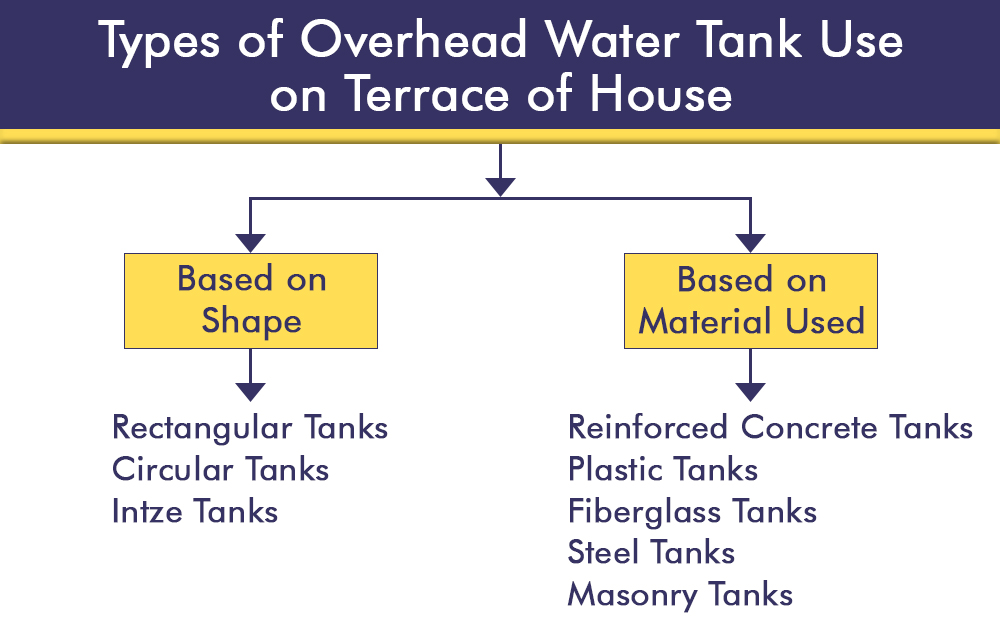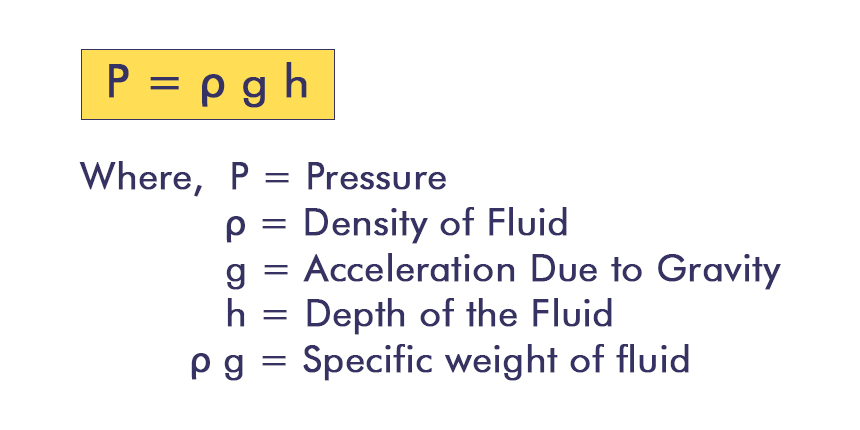Water is life and hence having an efficient water storage system in a house is a must. Water tanks are storage containers of water that generally are used to storing water for consumption, irrigation, livestock, agriculture, rainwater harvesting etc.
The water tank design ensures that safe drinking water can be supplied even after prolonged storage, optimized cost, maximum service life, and performance in a disastrous situation like earthquakes. Here, in this article, Gharpedia is going to discuss about the perfect height of overhead water tanks to be placed over terrace.
What is Overhead Water Tank?
As the name itself suggests, Overhead Water Tank is a standard water storage tank situated at a certain height over a structure. The tank can be made of any material. Overhead water tank is also known as Elevated Water Tank or Water Tower.
Types of Overhead Water Tank Use on Terrace of House

Now that you know about the overhead water tank and their different types, choose the type of overhead water tank as per your need. As far as the height calculation is concerned, follow the steps mentioned below.
How to Find Out the Complete Height of Overhead Water Tank?
Step 1: Find out the Maximum Daily Demand Necessary for Persons in the House
Suppose, Number of person = 5
Maximum Daily Consumption = 180% of average daily demand
= 1.8 X Average Daily Requirement
According to Indian Standard code – IS 1172[372]: 1993 (Code of Basic Requirements for Water Supply, Drainage and Sanitation),
The Demand of Water for Domestic Purpose = 135litres / capita / day
Average Daily Requirement
= Water demand x Number of Person
= 135 x 5
= 675 lit / day
So, Maximum Daily Demand = 1.8 X Average Daily Requirement
= 1.8 X 675litres / day
= 1215litres / day
= 1.215 m3 / day
However, with upgraded in living standards and due to many gadgets, garden and vehicles in the family, the average demand may shoot up to 200 litres/day per person. In that case max demand would be 1800 litres/day.
Consider the Storage Factor:
How many days of storage you will provide on terrace? This will again depend on many factors such as:
01. Whether the supply is 24 X 7 or for few hours i.e. 1 hour / 2 hours everyday.
02. Whether there is sufficient pressure head in supply mains, so that the water can reach your terrace without any mechanical interference such as pumps.
03. Do you need to construct an underground water tank also for storage?
04. How reliable is your supply system?
Step 2: Assume Dimensions of the Overhead Water Tank
Now, if the supply is regular and you have an underground storage tank too, you must build the underground tank of a capacity that is enough to supply water for at least one day and overhead tank of half the capacity of the underground tank.
However, if the supply is erratic, you need to have underground water tank ofa capacity to supply water for at least 2 days and overhead tank of half the capacity of the underground tank. If you are opting for a readymade tank, check the size and see whether you can accommodate it on terrace. Also, check that it is easy to lift the tank to the top floor of the structure. In case of apartments the same logic will apply, however, apart from the domestic demand of each flat owner, factors like water allocation for fire fighting, landscape and other miscellaneous needs too will be taken into account.
Step 3: Find out the Ideal Height of Overhead Water Tank
The height is an approximate value of our assumed dimensions of tank. It is finalized after the necessary checks included in the tank design.
Height of Water Tank from Terrace
Why It Is Important To Construct The Overhead Water Tanks at Some Elevated Height?
01. The overhead water tank is constructed at height because it should constantly supply water for all processes. It also eliminates the need to pump water from an electric pump or booster pump.
02. The overhead water tank eliminates the immediate need for water for domestic and fire purposes and is free from the risks of pumping equipment failure during emergencies.
03. The elevated tank does not require continuous pump operation, as the pressure is maintained by gravity.
04. In addition, the height of the water tank is also important for maintenance purposes. The depth of the tank should be such that a person can easily get inside it and clean it.
The height of the water tank from terrace (Clear height between bottom of water tank and terrace) is of great importance. So what is the ideal height for the same?
Apart from this, if your house has a roof, then you will have to install the overhead water tank on a stand, which can be made out of wood or metal. Sometimes stands are also used on the terrace to install the overhead tank. So how do decide the height of the stand? Let us understand the basic fundamentals behind it.
According to hydrostatic law, “The rate of pressure increase in a vertically downward direction at a point in a static fluid is equal to the specific weight of fluid”, as stated in “A TEXTBOOK OF FLUID MECHANICS AND HYDRAULIC MACHINES” by ‘Dr. R.K.BANSAL’[373].

At all points in the supply system, the pressure depends on the height of the liquid above it. With theincrease in height of the liquid, the pressure increases. The higher the height of overhead water tank from terrace, higher the water pressure.
The height of your tank affects the pressure water can generate. You can get water in your taps without using a pump when your tank is positioned at an adequate height.
Therefore depending upon the water pressure requirements you should finalize the specific height of the water tank from the terrace (Clear height between bottom of water tank and terrace).
Now, for all the faucets to operate smoothly, it must have a minimum pressure of 0.5 kg/cm2at theoutlet i.e. 5m head (at the highest delivery point). However, the same head for shower or flush valve is desirable at 1 kg/cm2 i.e. 10 m head.
This implies that the height of bottom of tank must be minimum 5 m above the tap or faucet on the top most floor and preferably it should be 10 m above the shower point on the topmost floor.
Imagine, when you install water tank right on the top of the terrace. In such a case the head for shower will be hardly 1.20 m and for faucet it will be 2 m. In such a case the showers will hardly work and even the faucet will operate at a slow speed and hence less flow.
That is the reason behind constructing overhead tanks on a staircase cabin or a mumpy that is normally 2.1m high. In such a case the head for tap or faucet will be 2.1 + 1.2 = 3.3 m head and for shower 2.1 + 1.00 = 3.1 m which will give pressure of 0.4kg/cm2and 0.3 kg/cm2 .Please however note that in this case too, the pressure in the shower will not be adequate and you will never enjoy shower.
Summing up, the primary purpose of an overhead water tank is to achieve even distribution of water, and to maintain constant pressure and flows. When the water comes down from a certain height at the time of discharge, it has a sufficient increase in pressure that makes it flow at a constant rate in almost every outlet.
As discussed above, the height of overhead water tank impacts pressure of the water distribution system. Therefore, the height of the overhead water tank must be adequate to ensure a constant minimum pressure to all outlets.
Also Read:
Water Storage Tanks (for a Residential Water Storage)
Plastic vs Concrete Water Tanks: Make a Right Choice for Your Home!
Image Courtesy: Image 1




